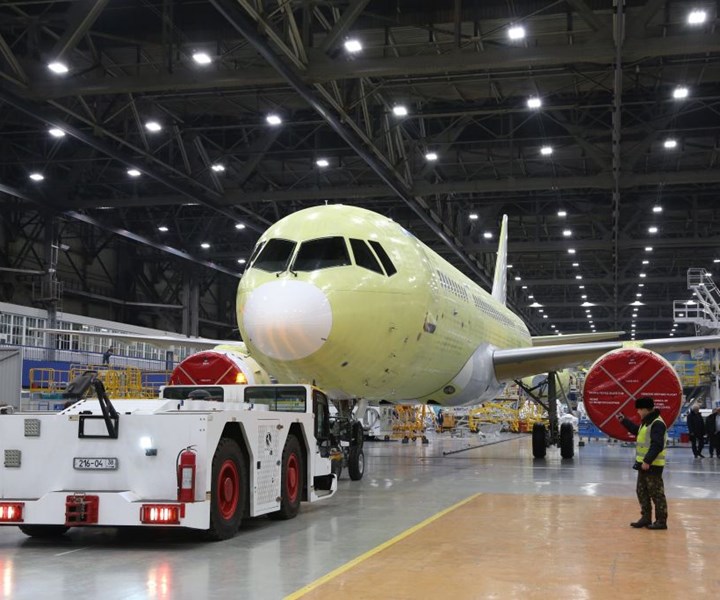Irkut Corp. completes construction of fourth MS-21-300 flight test aircraft
Russian jetliner with OOA infused wing steps nearer to certification. See CW’s historical timeline of the MS-21.

Source | Irkut Corp.
The Irkutsk Aviation Plant, a branch of Irkut Corp. (a part of United Aircraft Corp., Moscow, Russia), has completed systems diagnostics of the fourth MS-21-300 aircraft designed for flight tests.
The results of first prototypes testing were taken into account in the aircraft production process. Three of these aircraft are now undergoing flight tests, while two of the four continue undergoing static tests, in pursuit of certification from the European Union Aviation Safety Agency (EASA, Cologne, Germany) for flight and entry into service.
On Nov. 28, the newest aircraft was transferred from the final assembly shop to the plant's flight-test division.
The MS-21 features the world’s largest infused, out-of-autoclave carbon fiber composite wings, which are manufactured by AeroComposit (Moscow, Russia). For more on the manufacture and progress of the MS-21 and its composite wings, see CW’s timeline of past coverage:
In Nov. 2019, the MS-21 completed its third flight test for EASA certification.
In Aug. 2019, Irkut Corp. presented MS-21 to the public for the first time.
In. March 2019, the third MS-21-300 joined the flight test program.
In Feb. 2019, EASA completed the first flight session of the MS-21-300 certification program.
In Jan. 2019, Irkut Corp. completed construction of the third MS-21 test aircraft.
In August 2018, CW published a case study on the MS-21’s infused and co-cured composite wings, and the implications for the future of aerocomposites.
In July 2018, the second MS-21 test aircraft completed a successful flight.
In Oct. 2017, an MS-21 test aircraft flew from Irkust, Russia to Moscow.
In July 2016, a MS-21 composite wing box was delivered for static tests.
In June 2016, Irkut announced that its MS-21 out-of-autoclave (OOA) wing and wing box were nearly ready for their first flight.
In Jan. 2014, CW reported a case study on the resin-infused MS-21 wings and wingbox.
In 2011, FACC first revealed the composite wing box for MS-21 aircraft.
Related Content
-
Clean Sky 2 outer wing box demonstrator validates OOA LRI, shimless assembly and SHM
Full-scale wing box project achieves TRL 5 with 2% weight reduction and 4% reduction in recurring production costs through improved manufacturing efficiency and assembly processes.
-
Prepreg compression molding supports higher-rate propeller manufacturing
To meet increasing UAV market demands, Mejzlik Propellers has added a higher-rate compression molding line to its custom CFRP propeller capabilities.
-
Composite Integration presents webinar on liquid resin infusion
On July 30, 2025, company experts will discuss the role of LRI in delivering scalable, OOA composite production for the aerospace sector.






